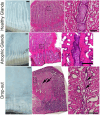Applied anatomy and morphology of Meibomian glands in the non-human primate
- PMID: 40596124
- PMCID: PMC12218872
- DOI: 10.1038/s41598-025-05452-9
Applied anatomy and morphology of Meibomian glands in the non-human primate
Abstract
Dry eye disease (DED) is a common ocular condition that has been estimated to affect ~ 10 to 55.4% of the global population. Symptoms of DED include eye irritation, ocular pain and discomfort, inflammation, and photophobia, and, if left untreated, can lead to infection, corneal neuropathy, corneal scarring and impaired vision. Studies have shown that over 70% of all DED cases are caused by some form of Meibomian gland dysfunction (MGD). To date the etiology of MGD remains unknown, therefore, there is a need for further research into understanding the development, homeostasis and pathology of the Meibomian gland (MG). Various animal models, such as, the murine, rabbit and canine models, have provided valuable insights into the physiopathology of MGD, however, there are many limitations when comparing these models to human MGD. The nonhuman primate (NHP) model is closely related to humans and develops many diseases comparable to humans. This study aimed to characterize the anatomy and morphology of the NHP Macaca mulatta MGs compared to humans. MGs were analyzed by whole mount imaging and histology in the eyelids of NHPs of various ages ranging from ~ 3 months to 12 years. NHPs presented serially arranged MGs within the upper and lower tarsal plate with similar gland morphology to that of humans. Curiously, in the upper lid, the centrally located glands presented a distal portion that is thinner than the remaining glands, with meibocytes directly lining the central collecting duct instead of forming acinar structures. MG atrophy and drop-out were evident in both upper and lower eyelids of NHPs from 6 years of age, increasing in severity with age. Both MG tortuosity and hooking were observed in the NHPs at all ages, being more prevalent in the lower eyelids than in the upper eyelids. Taken together, our findings show that the NHP could be a valuable model for studying MG development, homeostasis and pathology, including Age Related MGD (ARMGD).
Keywords: Aging; Meibomian gland; Non-human primate; Ocular surface.
© 2025. The Author(s).
Conflict of interest statement
Declarations. Competing interests: The authors declare no competing interests.
Figures








Similar articles
-
Meibomian gland characteristics in children: A narrative review.Ophthalmic Physiol Opt. 2025 Sep;45(6):1244-1260. doi: 10.1111/opo.13552. Epub 2025 Jul 2. Ophthalmic Physiol Opt. 2025. PMID: 40600588 Review.
-
Interventions for chronic blepharitis.Cochrane Database Syst Rev. 2012 May 16;2012(5):CD005556. doi: 10.1002/14651858.CD005556.pub2. Cochrane Database Syst Rev. 2012. PMID: 22592706 Free PMC article.
-
Calcium-Dependent Regulation of Desmosomal Proteins in Human Meibomian Gland Epithelial Cells.Invest Ophthalmol Vis Sci. 2025 Jun 2;66(6):49. doi: 10.1167/iovs.66.6.49. Invest Ophthalmol Vis Sci. 2025. PMID: 40521979 Free PMC article.
-
Efficacy of meibomian gland expression combined with Home-Based therapy in the management of dry eye Disease: A systematic review and Meta-Analysis.Cont Lens Anterior Eye. 2024 Apr;47(2):102107. doi: 10.1016/j.clae.2023.102107. Epub 2023 Dec 22. Cont Lens Anterior Eye. 2024. PMID: 38135593
-
Topical treatments for blepharokeratoconjunctivitis in children.Cochrane Database Syst Rev. 2017 Feb 7;2(2):CD011965. doi: 10.1002/14651858.CD011965.pub2. Cochrane Database Syst Rev. 2017. PMID: 28170093 Free PMC article.
References
-
- Knop, N. & Knop, E. Meibomian glands. Part I: anatomy, embryology and histology of the Meibomian glands. Ophthalmologe106(10), 872–883. 10.1007/S00347-009-2006-1 (2009). - PubMed
-
- Andrews, J. S. The Meibomian secretion. Int. Ophthalmol. Clin.13(1), 23–28. 10.1097/00004397-197301310-00004 (1973). - PubMed
MeSH terms
Grants and funding
LinkOut - more resources
Full Text Sources

